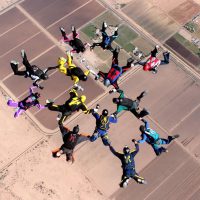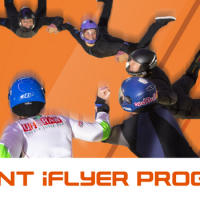Written by Tunnel and Outdoor skydiver – Garnett Znidaric (E414 – 1,400 jumps – 12 hours of tunnel)
“It will be easy,” he said.
“What about?” I said.
“Why you like the tunnel,” he said.
“Hmm… okay,” I said
I have been a tunnel fan since I first saw the pictures back in the 80’s. On the other hand, I didn’t get to play in a tunnel until 2012. That was when I found out that a lot of the stuff we were teaching as B-Rel coaches back in the 80’s didn’t really work.
Since then I have flown in tunnels in Malaysia, Singapore, Eloy and of course, Sydney. Not as much as I like but enough to tell budding skydivers that it is the place to polish existing skills and develop new ones. Let me be clear though, I just do belly stuff although I have unenjoyable dabbled with the dark side of free flying.
It has often been said that knowledge you take from the sky won’t do much for you in the tunnel but what you learn in the tunnel will help you immensely in the sky. For the most part, I would emphatically agree. Here are some thoughts
Pros
-Cheap skydives-
Shared between 4 people a minute of freefall in the tunnel costs less than $10 each. Even 2 ways are an economic way of flying and when you are starting out
-No slipping and sliding-
The wall of the tunnel is unforgiving so you quickly learn whether or not you are flying sideways or backsliding. Often instructors will encourage people who have just completed their AFF course to start on their B Certificate relative work jumps. Personally, and I am not an instructor but rather someone who has watched people evolve in all aspects of skydiving for a number of decades, I would suggest that people after they complete their AFF they go straight to the tunnel and work on their basic body flight and B-Rels in the tunnel. If you still have jump numbers to build up for the A Certificate, then put the effort into canopy control as this is often the weakest skill and yet at many drop zones, a most critical one to develop due to high levels of canopy traffic.
-Time to breathe-
One great thing in the tunnel is that if you feel stress building up, as you go through drills or developing freefall comfort, you can simply stop and take the time to breathe. I can remember being in a rush to prepare for an overseas trip and I was rushing and flying far from well. Without having to worry about breakoff, spending height, I just stopped, looked across at the tunnel buddy, smiled and breathed deeply. Recommencing the routine, the docks were soother and faster.
-No climb to height or packing-
At the tunnel, the focus is all about the freefall at a terminal. This means you don’t have to worry about the ride up in the plane, canopy flight and packing. One minute of freefall can be followed by another one instantly. To me, this means that a lot of stress is removed and I and my colleagues in the tunnel can focus on flying.
-Instant debrief-
And once you get out of the tunnel, more than likely the video clip of your session is coming up on the screen in the antechamber to show you what happened. Sometimes from the side and sometimes from above. This is invaluable in identifying strengths and weaknesses and honing new skills.
Cons
-Using wrong references-
The only real negative I have seen people fall into the habit of is using a reference outside of the group. While it is imperative that you get used to accurate height control and stay around the middle of the doorway about a meter above the net, it is also important that you use the other members of your belly team as a reference for outward facing positions in formations. In the sky, there are no such references as the wall or doorways.
-Walls hurt. Be honest to tunnel supervisors-
Not really a point against tunnels but rather a caution to new skydivers entering the tunnel for the first time either by themselves or to join a group. Always be honest with your organiser and the people at the tunnel about your level of experience. This way you can be helped through your progression. The sky is very forgiving in many ways. The walls of the tunnel are not. On the other hand, if you can sit still in the tunnel, then you will know you are not the one backsliding in the sky.
Exercises
-Work on smooth NOT complex-
If you haven’t done burble hops as two ways, don’t take a four way in there and expect to turn blocks involving crossovers and expect them to work. Often I have seen inexperienced groups of four in the tunnel trying some fun stuff but with inappropriate skill sets the result has been lots of hitting walls and bouncing off the net to the disgust and frustration of the person on the door of the tunnel.
-Stop and smile-
Having learnt that slow is smooth and smooth is fast, a great exercise in the tunnel is to go through your formation stuff but stop before you take the dock and wait for the person keying the moves to give the key. In this way you slow down, stop rushing and become aware of those around you.
And smile. This is meant to be fun. Also being relaxed allows for you to feel more comfortable in the air. To be relaxed and enjoy every second of being in the wind.
In Summary
The tunnel is fun and great place to learn new stuff and polish existing skills. For the most part, I have never heard a valid argument for not going to the tunnel to learn in preference to learning in the sky. A couple of hours a year in the tunnel will pay huge dividends in the sky. And you can have fun while you are learning. – Garnett Znidaric
The best way to make the most out of your outdoor/indoor skydiving is to book a coach who will be able to guide you and really accelerate your learning.
You can arrange a coach on your schedule by emailing coaching@ifly.com.au or call 1300 366 364.
Otherwise, you can check out the Frequent iFLYER Facebook page for all upcoming training events, news and indoor skydiving tips!









 The programme works very much like an airline programme. Every time you fly (qualifying block time), your Frequent iFLYER time accumulates and you progress through status tiers from Bronze to Silver, Gold and Platinum, with incremental benefits at each tier. Enrollment is automatic and the first status level of Bronze is awarded at just 60 minutes of block time flown.
The programme works very much like an airline programme. Every time you fly (qualifying block time), your Frequent iFLYER time accumulates and you progress through status tiers from Bronze to Silver, Gold and Platinum, with incremental benefits at each tier. Enrollment is automatic and the first status level of Bronze is awarded at just 60 minutes of block time flown.